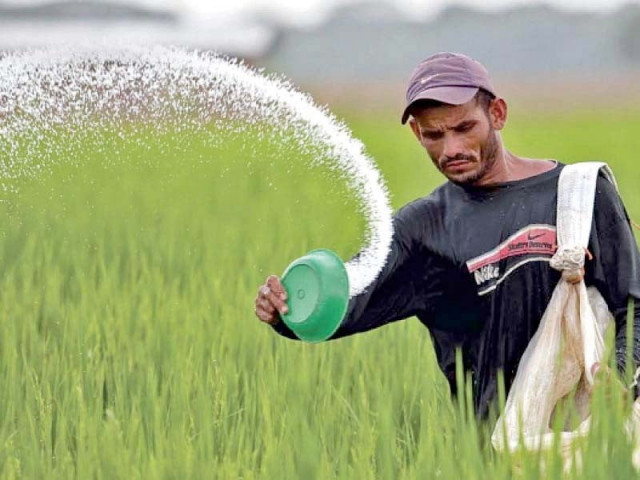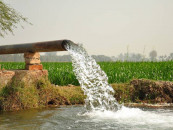Fertiliser subsidy issue lands in SIFC
Govt mulls shifting fertiliser plants to Mari gas for cost efficiency

The issue of direct subsidy to farmers on fertiliser has landed with the Special Investment Facilitation Council (SIFC) despite the fact the experiment has failed in Punjab.
Sources have told The Express Tribune that the SIFC had taken up the matter of direct subsidy to farmers on fertilisers in a recent meeting and directed the ministries of food and industries to find out solution.
A proposal is being discussed that all fertiliser plants should be shifted to the Mari Petroleum Network from other gas utilities. The sources say that Mari petroleum gas rates are lower compared to gas utilities rates.
In Pakistan, affordability of urea has been ensured over the last two decades through domestic production based on provision of gas from Mari gas fields as feedstock, thereby benefiting the farmers much more than the intended benefit due to lower cost of production.
The lower price of urea -- ranging from two to five times less than international prices – in the recent past is a testimony to the successful model through domestic production. This model through fertiliser industry has worked well in line with the stated objectives of the Fertiliser Policy, 2001.
However, there have been voices against it, suggesting a direct subsidy disbursement mechanism. The federal government has struggled to effectively disburse subsidy benefit directly to farmers nationwide to overcome serious challenges to the agricultural sector because of price hike of imported fertilisers in the international market.
In 2016-17, a Kissan package was introduced by the federal government to reduce urea prices through a subsidy of Rs100-156 and a reduction in the general sales tax (GST) from 17 to 2%.
The industry passed on the intended benefit to the farmers. However, due to sluggish processing the industry is still waiting for the disbursement of pending subsidy payment of Rs19.2 billion and around Rs70 billion GST refunds.
Hence, the fertiliser manufacturers do not find enough motivation for any such scheme. There are suggestions for the disbursement of direct subsidies to the farmers due to IMF pressures on the government to do away with indirect subsidies.
Experts underscore the importance of studying the prevalent challenges of direct subsidy disbursement and the development of an indigenous model that can be applied across the country for the benefit of the entire farming community.
The subsidy scheme, which aimed to alleviate the financial burden on farmers grappling with the high prices of phosphate fertilisers, has encountered multiple hurdles in its execution.
In a bid to provide direct subsidy to bolster the agricultural sector, the government of Punjab had introduced a voucher-based SMS-enabled direct subsidy mechanism for phosphate fertilisers in the past years.
The vouchers were placed in the fertiliser bags and farmers would send the code on the voucher on a given number through SMS. Payment instructions would be received through system generated message.
However, despite earnest efforts, it did not work to the satisfaction of farmers, who has actually purchased expensive fertiliser through cash payments with a hope of receiving the promised subsidy. It is believed that a persistent shortage of funds prevented many farmers from cashing the coupons.
Notably, in Sindh, Khyber-Pakhtunkhwa (K-P), and Balochistan, this subsidy was entirely unavailable to the farmers, therefore various malpractices like trading of stickers were observed.
Moreover, this scheme required farmers to purchase fertilisers at market prices, in anticipation of government subsidies, would demand a substantial additional cash outlay.
Therefore, another suggestion for direct cash subsidy to farmers based on land records on the line of BISP has been floated. This proposal also poses significant challenges in Pakistan, especially given the state of land documentation across various provinces.
Except for Punjab, land records on the provinces are neither fully updated nor computerised, making it difficult to accurately identify the beneficiaries. Furthermore, the complex structure of farming in Pakistan, where many landowners do not actively farm themselves but lease out their land to tenants, adds another layer of difficulty.
In such cases, the cash subsidy may not reach the actual farmers, who are directly involved in the cultivation process. Additionally, small farmers, who receive direct cash payments, are vulnerable to using the funds for non-agricultural purposes, given their financial pressures.
This misallocation of resources forces them to eventually purchase essential inputs like fertilisers at inflated prices, often relying on loans from local middlemen (Arhtees). As a result, the intended benefits of the subsidy are undermined, with farmers continuing to face financial hardships and rising production costs.
This highlights the need for a more targeted approach to ensure subsidies effectively support the agricultural sector. Therefore, based on farmers experience and recent experimentation, it is evident that any knee-jerk decision on the subsidy disbursement system for short-term political gain could significantly escalate production costs for farmers.
This would not only jeopardise crop yields but could also trigger far-reaching negative political repercussions for the administration responsible, as it risks undermining the agricultural sector's stability and food security.
The experts say that it is crucial to emphasise that the indirect subsidy through relatively cheaper natural gas provided as feedstock has worked well as farmers have reaped the benefit of substantially lower prices of locally produced fertilisers, in the highly volatile international market and devaluation of Pakistani currency.
Today, the local urea is selling around Rs4600 per bag cheaper than the import price, besides saving foreign exchange to the tune of $2.7 billion per annum.
It may be of interest to note that Rs150 billion indirect subsidy through lower feedstock gas prices by the federal government is translated into over Rs400 billion benefits to the farmers by the industry on an annual basis.















1726134115-0/BeFunk_-(41)1726134115-0-208x130.webp)






COMMENTS (1)
Comments are moderated and generally will be posted if they are on-topic and not abusive.
For more information, please see our Comments FAQ